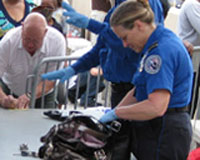TSA Still Asks You to Show Your Bodies
By Rakesh Raman
Notwithstanding the travelers’ outcries against getting their full bodies exposed under the scanning machines manned by humans, Transportation Security Administration (TSA) in the U.S is still pushing its diktats to attract public support.
While there is hardly any evidence of public support, TSA administrator John S. Pistole issued a public service announcement Monday, Nov. 22, to thank the traveling public for their continued support for the newly implemented procedures.
Here’s what he said: “Hello. This is TSA Administrator John Pistole. On behalf of the more than 50,000 Transportation Security Officers across the country, thank you for being our partners in security.”
“For your safety, we have instituted new screening procedures at checkpoints. Please take a moment to read the materials available about these procedures and your options as a passenger. We appreciate your patience as we all work together to keep travel safe,” Pistole concludes.
TSA, an agency of the U.S. Department of Homeland Security, has issued new screening rules beginning this month, Nov. 2010.
The new screening procedures, including a full-body pat-down at airports, are drawing flak from people in the U.S.
To garner public support and draw the attention of authorities toward this largely unpopular system, a video news service NaturalNews.TV informed that a rap artist has released his latest song that takes aim at Big Brother’s X-rated airport pat-downs.
“Don’t Touch My Junk” is released as a free download at NaturalNews.com.
Created by Michael Adams, “Don’t Touch My Junk” is meant to expose the aggressive, obscene pat-down procedures now being used by the TSA on air travelers. (Read: TSA to Face the Music: Don’t Touch My Junk)
The TSA message is being made available to airports in the U.S. to play on public announcement systems during this holiday travel season to ensure passengers are prepared for screening when coming through airport security checkpoints.
This announcement is just one in a series of steps by TSA to communicate to the traveling public.
The TSA drive includes a video message to travelers, posters at airports and messages to the TSA workforce on how to carry out these procedures in the most professional and responsible manner.
Moreover, to provide passengers with 24×7 access to information on their mobile device, TSA has developed the MyTSA mobile application.
The aim, TSA says, is to ensure easy access to information you need to get through security and onto the plane safely and smoothly.
By Rakesh Raman, the managing editor of Raman Media Network.
Photo courtesy: TSA





